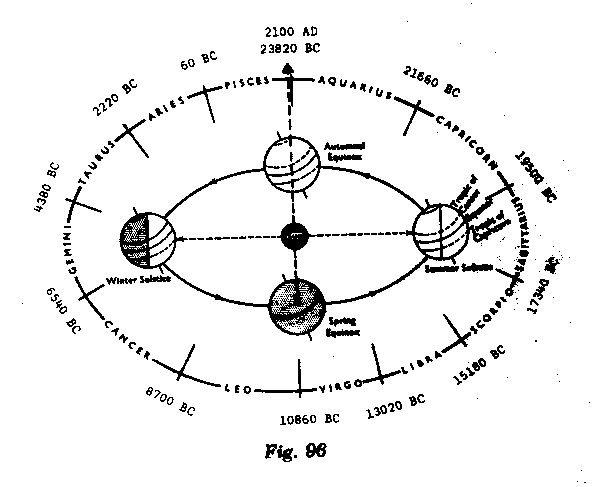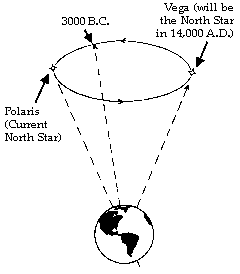Mass of the Christ, the Ultimate Piscean
Precession
At this time of year the Western World, and due to its dominance much of the rest of our planet, notes the birth of Jesus Christ. In my other blogs I present the ideas of precession and the Ages of Man. To quickly review, the Earth spins on its axis at a tilt of 23 degrees. Not only does this provide our seasons, but also our “Ages.”
Figure i, Precession of the Earth
Every 2000-2250 years the axis points at a different constellation due to this precession. In other words, lie a top spinning on an axis, the axis itself traces another secondary circle in the sky. Currently this axis points close to Polairs, the North Star, in Ursa Major, the Big Dipper.
Figure ii, Earth’s Calendar


Age of Taurus
As the planet wobbles, it traces backwards through each of the constellations our twelve months travels forward through. During the mythical time of Moses, we left the Age of Taurus, or “The Bull.” All around the world, temples independently worship its characteristics such as desire, fertility, agriculture and production.
These ideas are shown in agricultural and fertility symbolism in temples as well as the phallus, the bull fight, Hindu cow worship et cetera. In keeping with the Christian theme, the great story of the Golden Calf, illustrates what happens when Moses leads his people out of the Egyptian land of the Bull into the Age of Aries.
Aries represents the “heady” fire. In others words it represents fire in the head area, or intellectual fire wisdom and vitality as driven by the archetypes of Mars and Saturn. For the layman these are aggression and structure. Earth experienced the expansion of empire, and iron age cultures during this time.
Age of Pisces
Why Christmas
Finally, Yeshua, better known as Jesus the Christ, came to become the Scapegoat of the Age of Aries as he ushered in the Age of Pisces. He was sacrificed for the sins of the Jewish people, and for all, as commemorated at this time of year in Christmas-the heart of our discussion.
In the article “Why December 25?,” the following two paragraphs succinctly annotate the choice of this date in history:
The eventual choice of December 25, made perhaps as early as 273, reflects a convergence of Origen’s concern about pagan gods and the church’s identification of God’s son with the celestial sun. December 25 already hosted two other related festivals: natalis solis invicti (the Roman “birth of the unconquered sun”), and the birthday of Mithras, the Iranian “Sun of Righteousness” whose worship was popular with Roman soldiers. The winter solstice, another celebration of the sun, fell just a few days earlier. Seeing that pagans were already exalting deities with some parallels to the true deity, church leaders decided to commandeer the date and introduce a new festival…
The pagan origins of the Christmas date, as well as pagan origins for many Christmas customs (gift-giving and merrymaking from Roman Saturnalia; greenery, lights, and charity from the Roman New Year; Yule logs and various foods from Teutonic feasts), have always fueled arguments against the holiday. “It’s just paganism wrapped with a Christian bow,” naysayers argue. But while kowtowing to worldliness must always be a concern for Christians, the church has generally viewed efforts to reshape culture—including holidays—positively. As a theologian asserted in 320, “We hold this day holy, not like the pagans because of the birth of the sun, but because of him who made it.” (Christianity Today, 2007)
So, in other words, the actual date of Christ’s birth and the choice of a mass commemorating it come from accretion. Nearly all religion forms from the subsuming a host of commonly held beliefs.
Yet for the record, the Age of Pisces, the fish, represents that of compassion and personal self-sacrifice as embodied by the avatar of that age, the Christ. His stories constantly speak of “Fishers of Men,” and virgin metaphors from its corresponding sign, Virgo. Remember the fish sign bumper stickers or the Darwinian ones with feet on them!
Coming next we have the Aquarian Age where the axis traverses, or transits, the Constellation of Aquarius which is ruled by the planet Uranus. Rather then delve into that here on the most Piscean of occasions, I will only add a vital caveat. Astrology is about correlation rather than causation.
We see the correlations between human behavior, myths, and deep seated human archetypes. The stories of the world illustrating human character arise from the depths of our common shared genetic history and nature of being-dharma. All humanity share these themes to one degree or another. Merry Christmas Pisceans, prepare for the Aquarian next year.
References:
Christianity Today International (2007). “Why December 25?” Retrieved December 25, 2007, from http://www.christianitytoday.com/history/newsletter/2000/dec08.html
Elie, Benedict (2004). “The Age of Pisces and the Age of Aquaries.” Retrieved December 25, 2007, from http://www.astrosoftware.com/AquariusPiscesAge.htm
Grand Ages and the Coming of Aquarius (2007). Retrieved December 25, 2007, from http://www.greatdreams.com/ages.htm








Leave A Comment